|
|
| |
|
|
|
|
| |
Big Trees: Pictures & Politics |
|
|
|
| |
|
|
|
|
| |
From Sacred Symbol to Industrial Stumpage |
|
Big Trees as Recreation |
|
| |
Big Trees as Natural Monuments |
|
Big Trees as Curiosities |
|
| |
Big Trees as Cathedrals of Nature |
|
Big Trees as Commercial Products |
|
| |
Big Trees as Trophies |
|
On the Wrong Side of Environmental History |
|
| |
Big Trees as Objects of Science |
|
Greenwashing Weyerhaeuser |
|
| |
|
|
|
|
| |
|
|
| |
|
|
|
|
| |
On the Wrong Side of Environmental History
Who is responsible for the annihilation of our last big trees? A main culprit is Weyerhaeuser, the voracious American tree cutting corp and one of the world's principal destroyers of ancient forests. In 1999 Weyerhaeuser acquired MacMillan Bloedel, Canada's largest logging corp, for US$ 2.45 billion, thus getting control over 31 million acres of Canadian forestlands, including three million acres in British Columbia (BC). In BC, where government policies serve the logging industry, Weyerhaeuser's consolidation of power was a disaster for the already vanishing old growth forests. A Weyerhaeuser log dump in the Upper Walbran Forest on Vancouver Island is filled with the corpses of irreplaceable big trees (right). A similar rampage by Weyerhaeuser on Haida Gwaii caused the Haida Nation to revolt in 2004. |
|

Weyerhaeuser log dump, Vancouver Island, 2003
Photo: Karen Wonders |
|
| |
|
|
|
|
| |
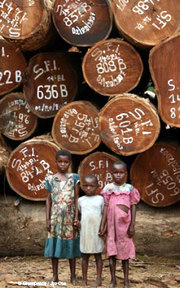 African girls in old growth log dump certified by industry
African girls in old growth log dump certified by industry |
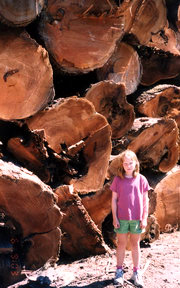 Canadian girl in old growth log dump owned by Weyerhaeuser
Canadian girl in old growth log dump owned by Weyerhaeuser |
|
|
Greenwashing Weyerhaeuser Weyerhaeuser is known to environmental and forest historians as a financial sponsor and patron of their educational activities. This is a compromising situation, whereby history is instrumentalized to help greenwash Weyerhaeuser and protect the wood products industry rather than the endangered old growth temperate rainforests and boreal forests of North America. Sustainable old growth logging is greenwash. The image of three African girls standing in a certified old growth log dump (far left) is used in a campaign by Greenpeace Europe to stop the commercial destruction of ancient trees everywhere in the world. Canada is not included yet Weyerhaeuser's old growth log dump in the Upper Walbran Forest on Vancouver Island, British Columbia (left) is equally grotesque as the one pictured in Africa. In both cases ancient forest biodiversity is ruined for short term greed. |
|
| |
|
|
|
|
| |

"From Sacred Symbol to Industrial Stumpage"
Poster by K. Wonders, 2004 |
|
In 2000, Edward O. Wilson and over 400 other international scientists signed a
declaration calling for the cessation of the clearcut logging of BC's old growth rainforests, among the rarest and
most biologically productive ecosystems on Earth.
In 2004, the American Society of Environmental History (ASEH) held its annual meeting in Victoria, the capital city of BC. This was the first time that the ASEH conference, which attracts scholars internationally, was held in Canada and, to mark the occasion, environmentalists Ingmar Lee and Karen Wonders formally requested that the governing board of environmental and forest historians follow scientists in drafting a 2004 "Declaration Against Ancient Forest Logging."
No such declaration was adoped. Because many an academic reputation in environmental and forest history is made with Weyerhaeuser financial aide, careerist opportunism prevailed, and there has been no resolution to the compromised position of the American Society of Environmental History in relation to the logging industry. |
|
| |
|
|
 |
|
| |
Scientists' Declaration (2000)
"Coastal temperate rainforests cover just one fifth of one per cent of the earth's land area.
These are among the rarest and most biologically productive ecosystems on Earth, containing more biomass (weight of organic matter) per hectare than any other ecosystem . . .
More than 53 percent of the coastal temperate forests of BC have already been industrially clearcut logged, an activity which disrupts or destroys complex vulnerable ecosystems of global significance. . .
[We] call for the immediate cessation of large scale clearcut logging in the watersheds of the Northwest Coastal temperate rainforests of Canada, to be replaced by ecosystem based forestry which includes areas of biological refuge, maintains the ecological characteristics of the original forest, respects and considers traditional knowledge, and provides for the long term sustainability of local communities." |
|
|

Weyerhaeuser fallers, 1922
Photo: Washington University |
|
| |
|
|
|
|
| |
|
|
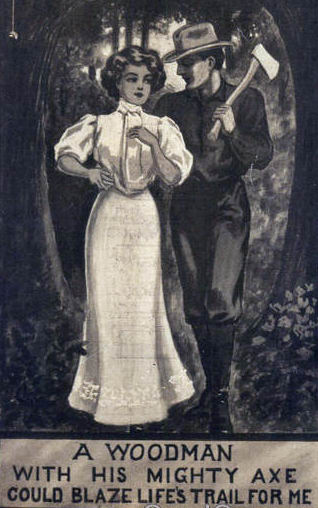 |
|
| |
|
|
|
|
| |

BC Forest History Newsletter logo
BC Ministry of Forests
Canadian forest history was early on appropriated by the American Forest History Society (FHS), established in 1946. This relationship is apparent in an FHS graphic that features its 1961 Weyerhaeuser - like logo in the middle of a maple leaf, better known as the Canadian national flag (right). Most FHS board members are beholden to industry and cannot freely address the forest destruction that has resulted. Yet the FHS disingenuously advertises: "Join the Forest History Society To Save Our Forest Heritage." |
|
Photos of lumberjacks felling big trees on the West Coast with axes and crosscut saws are a dime a dozen (above). This classic form of masculine trophy iconography has become a logo of the coastal logging industry. Also the Forest History Association of BC (est. 1982) adopted the "big tree being killed" logo for its newsletter (left), published by the BC Ministry of Forestry. Like its American counterpart, forest history in BC functions as an organ of the logging industry.
FHS website graphic, 2008
Forest History Society |
|
| |
|
|
|
|
| |


Huge piles of logs and wood chips used by Intercontinental Pulp, Northwood Pulp, and Prince George Pulp & Paper
to make pulp, most of which is exported around the world for paper products, Prince George, British Columbia, 2009 |
|
|
| |
|
|
|
|
| |
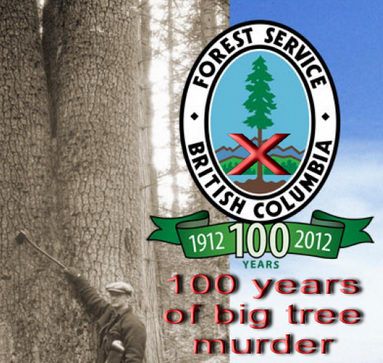
"Celebrating a Century of Big Tree Executions"
BC Forest Service centenary brochure (red text added) |
|
NiCHE (Network in Canadian History and Environment) was formed in 2004 to explore the historical context of crutial environmental issues such as deforestation. In 2009 NiCHE sponsored the BC Forest History Association Conference entitled "Exploring our Roots: Forest History in our Communities" in the industrial pulp and paper centre of Prince George (above). A keynote speaker was Mike Apsey, former board member of the Forest History Society, deputy BC forestry minister, president of the Council of Forest Industries, and award winner of the Canadian Pulp & Paper Association. Apsey is president of the BC Forest Service Centenary Society which is planning a celebration in 2012. Left: Featured on the centenary brochure cover, with its grovelling to industry, is the logo of the BC Forest Service. Note the cynical contrast of this big tree logo with the proudly displayed axe of execution, in this case imbedded in an ancient white pine. |
|
| |
|
|
|
|
| |
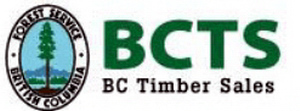
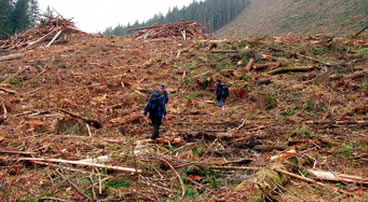
BC Timber Sales ruination of endangered species habitat
Old growth forest near Hope, British Columbia, 2005
Spotted Owl nesting ground clearcut logged
* * * Note contrast with the big tree logo of BC Timber Sales
|
|
|
The BC Forest Service logo is also used by BC Timber Sales (left), a government agency that facilitates the ruthless forest destruction industry. Thus "Forest Niche – Destroyer" Apsey insures that his 100 years of history celebrates the corrupt policy of accommodating big business. The truth is that the last big trees, the real and endangered niches of ancient forests, are being destroyed by the very people who fund forest history. In Absey's case he is even honoured for making available the records of his very crimes in his donated "Research Collection" at University of British Columbia. BC Timber Sales (BCTS) was created in 2003 to auction off Crown (public-owned) timber. Formerly known as the BC Small Business Program, BCTS decides where logging is to occur in BC and builds logging roads in the cutblocks with public money.
While it deceives the public with its phoney smokescreen about "sustainable" logging, BCTS desecrates the big tree habitat of endangered species such as the spotted owl (left) and forces native communities to defend their tribal land from clearcutting.
|
|
| |
|
|
 |
|
| |
 |
Left: Forest Products History Foundation logo,
designed in 1948
This logo presents the log driver as a heroic and masculine icon of forest history. The driver poles the big trees which lie prone under his feet in a log boom. With its saw edge circle design, the logo tributes the logging and sawmill industry. |
 |
Left: Weyerhaeuser Mill,
Snoqualmie, Wa., 1950
Photo: Josef Scaylea. This promotional photo emphasizes the bravery, strength and skill of the log driver who works in a huge boom pond at the Weyerhaeuser Mill. These logs are the last remains of the ancient wild forests and big trees of Puget Sound. |
|
|
| |
|
|
|
|
| |
The Forest History Society (FHS) originated in 1946 as the Forest Products History Foundation (FPHF). From about 1948 to 1955, the FPHF logo (above) pictured a burly male log driver standing on a log boom. This was replaced in 1961 by an abstract black triangle design similar to the Weyerhaeuser logo but repeated seven times, emphasizing the close tie between the Forest History Society and its industrial sponsor (Weyerhaeuser's motto: "Timber is a crop"). The uninspiring FHS tree farm logo lasted for over 40 years, until 2002, when it was replaced by a naturalistic ancient oak tree design, more akin to the "tree of knowledge" (left) seen in a National Book Festival poster. By now Weyerhaeuser's triangle logo had become synonymous with forest destruction (lower left). With its new "ancient tree" image, the Forest History Society proclaimed to launch environmental history into the 21st century – hence its disingenuous motto: "By understanding our past, we shape our future." A more honest, non greenwash motto might be: "By stumping our past, we misshape our future." |
|
 |
Left: Poster, 2004
National Book Festival to encourage reading sponsored by the Library of Congress and US First Lady Laura Bush

Above: Logo, 2004 Wake Up Weyerhaeuser!
Campaign to protect old growth forests sponsored by the Rainforest Action Network |
|
|
| |
|
|
 |
|
| |
Wake up WEYERHAEUSER!
SEARAG – Seattle Rainforest Action Group Campaign |
 |
"Weyerhaeuser; the planets largest timber harvesting and lumber production corporation, not only holds the title for largest logging corporation, but also for worst environmental offender in North America. Wiping out ancient lands, indigenous territories, old growth forests and endangered species habitats, Weyerhaeuser rapes our land of its beauty, leaving either mono – culture tree farms or barren wastelands to be deserted or trans – formed into oversized housing developments."
"All in the name of perpetual profit, the Weyerhaeuser Corporation has no regard for anything that stands in the way of their annual revenue. Continuing to clearcut their way across the continent, Weyerhaeuser leaves its mark, with a trail of barren clearcuts, and abandoned communities, all the while emphasizing a facade to investors and consumers of sustainability and ethics, that in all aspects are nothing more then a fictitious scheme of lies to cover the truth." |
|
|
| |
|
|
|
|
| |
Left: Protest at the Weyerhaeuser headquarters in Tacoma, Washington, in 2004. The demonstration against old growth forest destruction was part of the "Wake Up Weyerhaeuser: Protect Forests Now" campaign organized by the Rainforest Action Network: "Logging, distributing or selling endangered forests is a barbaric, outdated practice that has entered its endgame in the American marketplace. Any company that is still engaged in this practice is on the wrong side of history." |
|
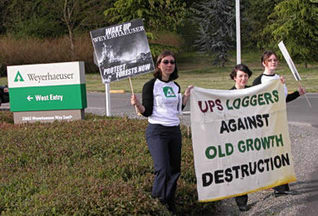
Anti Weyerhaeuser protest, Seattle, 2004
Photo: Rainforest Action Network |
|
| |
|
|
|
|
| |
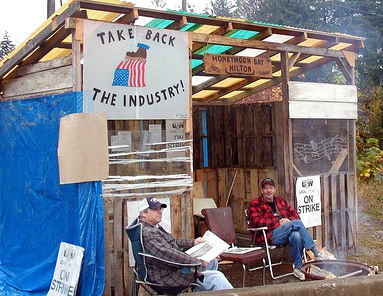
Bra002
Photo: Gen |
|
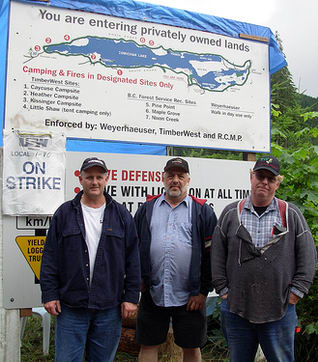
Bra002
Photo: Gen |
|
| |
|
|
 |
|
| |
No industry has had greater influence on society's understanding of nature than the forest products industry, which, by reshaping the concept of 'forest,' distorts understanding of the larger natural world itself. This industry fosters educational programs that, by down playing identification with wild nature, by emphasizing the utilitarian, and by training the public to accept relatively biologically sterile plantations as 'forests,' erode society’s respect for the splendor of unmanaged nature and for its right to exist. The apparent aim is to extinguish the awe for the opulence of wildness that comes so naturally to the young and to replace it with a commodity - oriented value system. As is invariably the case for projects created, funded and marketed by a profit driven industry, the aim is not the public interest but the industry’s bottom line" William Willers, The Forest Products Industry in Public Education (2008). |
|

"Sorting and grading lumber, Mill B, Everett"
Weyerhaeuser mural by Kenneth Callahan, 1944 |
|
| |
|
|
|
|
| |
Most of the ancient forests of North America have been wantonly hacked down by robber barons such as Weyerhaeuser. The company grabbed lands held in public trust in 1900 and continues its pillage today: in May 2008 Weyerhaeuser cut a dirty deal with Plum Creek Timber in Montana which netted the two forest liquidators a total of almost $700 million in tax breaks. We continue to give legitimacy to the wrecking of nature by making loggers into folk heros and by accepting ruthless capitalists as cultural patrons. The Forest History Society proudly proclaims that its existance is largely due to German immigrant Frederick ("Timber King") Weyerhaeuser, and his "personal dedication to preserving the history of the industry that built his family's fortune." The Society goes even further and pretentiously claims to be "unique as the only organization on the planet solely dedicated to preserving forest and conservation history." Back in 1944, Weyerhaeuser's logging propaganda was more directly shown in a series of murals (right).

Weyerhaeuser sawmill, Everett, c. 1928
Photo: University of Washington
"Mill B" was designed to facilitate the massive eastward shipping of old growth timber products by the Great Northern Railroad (above). Its president, James Hill, did a murky deal with Frederick Weyerhaeuser in 1900 that amounted to one of the largest single land transfers in American history, much of which included dubiously obtained public land. Weyerhaeuser continued to purchase timberland: it was a time of "timber billions" as proclaimed by a 1923 booklet published by three railway companies to drum up investment (right). The cover illustration shows four burly loggers struggling to move a log at a camp in the forest. Like the 1944 Weyerhaeuser mural series, the social realism style of the illustration seems to support the rights of workers. In reality, the illustration functioned as visual propaganda, disguising the dangerous working conditions and long hours of the poorly paid industrial labourers.
The Industrial Workers of the World Union was blacklisted in Everett and when a labour strike was staged, it culminated on 5 November 1916 in the infamous "Everett Massacre," a bloody confrontation that left five unionists dead. |
|

"Loading lumber onto a train, Mill B, Everett"
Mural by Kenneth Callahan, 1944
The murals were commissioned by Weyerhaeuser in 1944 for the cafeteria of its Mill B at Everett on Puget Sound. Painted by Kenneth Callahan in the social realism style of the 1930s, the scenes depict mill workers cheerfully performing tasks like loading piles of lumber (above). Built in 1903, Mill B (left) was reputed to be the largest mill in the world, one of four sawmills and two pulp & paper mills in Everett owned by Weyerhaeuser.

"Timber Billions," book cover, 1923
University of Washington |
|
| |
|
|
 |
|
| |
Visual propaganda is also effectively used on the cover of the January 2003 issue of Environmental History, which features a photo of two men standing in a grove of giant cypress trees in Arkansas (right). Seeking reader engagement, the journal's editor asks: "What do the trees mean to them? What is their relationship to each other, and to the photographer?" Aesthetic discussion aside, the photo was taken c. 1910, before industrial logging had laid waste to the old growth forests of the southern states. It is not a celebration of ancient tree grandeur, but rather records a stand of valuable "Cypress Timber" destined to be cut down and processed. Indeed the image belongs to the photo archives of the wood products industry which is named to honour a notorious forest destroyer, as well as a longtime board member of the Forest History Society:
Alvin J. Huss.
According to the Environmental History editor, the 2003 cover reflects a change in the journal policy: "Because environmental history is a graphics – rich subject. We also wanted the new cover to make more of a statement that the journal offers exciting and fresh insights into history, insights that flow from our appreciation of nature." This sounds good but is hypocrisy, because the journal does not face up to its cosy relationship with the wood products industry.

Hollow cedar stump, Whatcom Co., 1899
Photo: University of Washington |
|

Environmental History journal cover
January 2003 (red text added)
In 1999 the Forest History Society (FHS) announced: "Our journal, Environmental History, published jointly with the American Society for Environmental History remains the journal of record in the field, bolsters the scholarly reputation of the Society." Compromisingly, the logging industry is everywhere in the FHS, indirectly implicating scholars in forest destruction. Even the FHS photo digitization project is made possible by a pulp & paper – lumberman whose many corporations include International Paper and who is well known as an exterminator of ancient forests. Far more enlightening are the archival photos at the University of Washington, which give us a sense of the magnificence of the nature we have forever lost, cut down and replaced by tree farms. The stump from one giant cedar tree in Whatcom County contained a hollow wide enough for two horses to pass through (left).
Other FHS tributes to lumbermen include the Charles A. Weyerhaeuser Library and the Charles A. Weyerhaeuser Book Award. These run counter to just protests against deforestation by environmental activists and do a dishonour to younger generations who must live with the consequences of corporate abuse. |
|
| |
|
|
 |
|
| |

Weyerhaeuser Pulp and Paper Mill, 2007
Longview, Washington State
Weyerhaeuser's Longview pulp and paper mill (above) is the biggest producer of newsprint in North America, leaving a toxic legacy of pollution for future generations. It is hard to believe that 150 years ago this was the idyllic nature paradise at the mouth of the Cowlitz River pictured by the artist Paul Kane in 1847 (right). Settlers not only destroyed the river's rich salmon fisheries but they passed on fatal diseases to the Cowlitz and desecrated their burial places. |
|
Environmental historians must transfigure their scholarship into a programme of activism to save the ancient forests and rescue what is left of indigenous peoples and cultures, also in the US where logging corporations like Weyerhaeuser have pillaged and destroyed the forests and watersheds and polluted air and water with its toxic sawmill and pulpmill effluents.

"Burial Place on the Cowlitz River"
Engraving by Paul Kane, c. 1847 |
|
| |
|
|
|
|
| |
Greenwashing Weyerhaeuser This is the raison d'etre of the academic series Weyerhaeuser Environmental Books, edited by historian William Cronon. Cronon himself and some of the authors in his Series may well have impeccable scholarly and envionmentalist credentials. Yet there are two things wrong with their Series, or rather with its editor and authors. First, it is not right that environmental historians should be in bed with one of the worst forest destruction corporations in the world, helping greenwash its record of greedy clearcutting by conferring academic respectability on its environmental vandalism. Second, it is not right either that Cronon and his cronies – his fellow contributors – should derive fame and fortune from the study of, among other topics, indigenous peoples and native forests and simultaneously refuse to become activists in protecting these peoples, their cultures and their vanishing forests from the clearcutting onslaught of Weyerhaeuser and allied nature demolition forces. |
|

Anti Weyerhaeuser protest, Tacoma, Washington
Photo: Free Grassy Narrows |
|
| |
|
|
 |
|
| |

Anti Weyerhaeuser protest, Seattle, 2007
Photo: Free Grassy Narrows
Weyerhaeuser boasts that it is the world's leading corporate producer of lumber, pulp, paper, containerboard and so on. Could its patronage be the reason why an environmental publishing policy of "no paper" or such as the one below does not exist for the Environmental History journal or for the academic series Weyerhaeuser Environmental Books?
Ancient Forest Free Paper
100 Percent Post Consumer Recycled Paper
Processed Without Chlorine and Acid
Printed With Vegetable Based Inks |
|
|
As one critical environmental historian notes about the Cronon – Weyerhaeuser Series published by the University of Washington Press: "An advocate can make political capital by invoking the names of august academic institutions, regardless of the intention of a university press to publish books that stimulate critical thinking. Even with the good books in the Weyerhaeuser Environmental Books, more people will perceive Weyerhaeuser as pro – environment than will read the books to gain a more complex view."

Anti Weyerhaeuser protest, Seattle, 2007
Photo: Free Grassy Narrows |
|
| |
|
|
 |
|
| |

Anti Weyerhaeuser protest, Ottawa, 2007
Photo: Free Grassy Narrows

Anti Weyerhaeuser protest, Ottawa, 2007
Photo: Free Grassy Narrows |
|
On 21 September 2007 indigenous activists and their supporters organized a protest outside the Ontario Legislature (left) in Ottawa to demand that Aboriginal Title and Rights be acknowledged. Weyerhaeuser cannot accept the modern ethos of indigenous rights and ancient forest protection and as a result refuses to comply with the most minimal of ethical standards. For more on Weyerhaeuser's sustained assault on the indigenous people in northern Ontario to produce the lumber for its "green" Quadrant Homes, see the condemning report by the Rainforest Action Network:
American Dream, Native Nightmare.
It is more than just adding insult to injury, in fact, it is a moral outrage, when instead of activisim to save the little that's left of ancient forests and the indigenous cultures that depend on these, Weyerhaeuser scholars, such as Cronon, devise narrative constructs of history that exonerate settler society, even if done in the form of a sympathetic treatment of native peoples. The rapacious resource extraction economy is redwashed by depicting native peoples as accomplices in the environmental carnage that so cynically and wrongly has been termed "civilization" and glorified in western history. |
|
| |
|
|
|
|
| |

Catholic Indian School, Tulalip Mission, c. 1865
Photo: University of Washington |
|
|
"The best means to civilize the children of the
Indians would be to keep them away from their parents and connextions. They want, in the first
place, to become as orphans – that is to say, they
must forget their father and mother, as far as possible, to abandon the Indian habits with
less difficulties" E. C. Chirouse, 1863.
Report on the Tulalip Indian Reservation |
The Catholic priest E. C. Chirouse is the figure in black robes on the left in the archival photo taken at the Tulalip Mission c. 1865 (left). Tulalip Indian students in school uniforms pose behind the two priests. Chirouse was also an agent for the Office of the Commissioner of Indian Affairs and reported on the Tulalip Indian Reservation on 30 September 1863 (above). Missionaries such as Chirouse played a crutial role in the government's forced relocation of Indians from their homelands to reservation concentration camps. |
|
| |
|
|
 |
|
| |

"Indian Camp on Ballast Island," Seattle, c. 1900
Photo: University of Washington |
|
Many Indians refused to be relocated from their Puget Sound homes, choosing instead to continue the way of life they had practiced for thousands of years before the settlers had arrived. Seattle was founded in the mid 19th century as a sawmill town and its waterfront was developed to serve the lumber industry. A c. 1892 photo shows a sawmill and the tracks and cargo wagons of the Northern Pacific Railway as well as an Indian tent camp in the foreground (left). This was the only area left undeveloped on the Seattle waterfront, called "Ballast Island" after the ballast dumped here by timber cargo ships. It was also the only place where the indigenous people could navigate their dugout canoes and where they were allowed to camp while passing through Seattle. Ironically, probably the greatest number of "souvenir" Indian photos were taken at Ballast Island. |
|
| |
|
|
|
|
| |
|
Logged Off Land, Trout Creek, Snoqualmie National Forest
Snohomish County – Photos by Lee Pickett c. 1925 |
|
|
| |
|
|
 |
|
| |

Trout Creek, Snohomish County, c. 1913
Photo: Carl A. Schenck |
|
The grotesque checkerboard clearcutting of Mount Rainier is easily seen on Google Earth. The corrupt land grabs that facilitated this destruction consolidated the power of the timber industry. An example is the Snoqualmie National Forest, established in 1889. Above are four photos of one of the valleys in the forest after it had been logged and burned off (the railway tracks can be seen running along the trashed Trout Creek). Taken c. 1925 by Lee Pickett, such photos of eco demolition by industry were commonplace.
Trout Creek had been earlier photographed (left) by Carl A. Schenck, a German born and educated forester who headed the Biltmore Forestry School in North Carolina. Schenck took the photo c. 1913 during a field trip to the west coast and it is part of the illustrations he collected for a manuscript he wrote, glorifying private forestry. Indeed Schenck is regarded as a hero of the American timber industry for his gung ho promotion of private and "scientific" forestry. But Schenck's German forest training could never have prepared him for the magnificence of the giant trees of the wild primaeval temperate rainforests. No such intact forests remained in Germany or anywhere in Europe and Schenck and his lot reinforced the arrogance of the settlers in cutting down the grand forests of the Northwest Coast as a way of civilizing the wilderness and its inhabitants. |
|
| |
|
|
|
|
| |
The intact forests of the Northwest coast and their rich salmon bearing rivers and streams were destroyed and degraded by logging and mining, as well as by pollution from industrial plants and agricultural practices. The devastation caused to biodiversity and most especially to the indigenous nations, their plight, the creeping genocide and the extermination of their rich cultural traditions is not addressed by the self serving propaganda of the Forest History Society with its resource exploitation heros. Schenck surely will have witnessed the deprivation of the natives, who lived in shacks on the logged and burned off rainforests such as that shown in a 1905 postcard (right), but he showed no regard for the land rights of these people.
The studio portraits of four Snohomish elders (below) dispossessed from their land include Ruth Sehome Shelton (Siastenu). Mrs. Sheldon was widow of the well – known Snohomish leader and totem pole carver William Shelton. She was photographed on 16 November 1940 while visiting the offices of the Seattle Post–Intelligencer to bring warnings in the Chinook language of a long and hard winter. |
|

Indian shack, Snohomhish County, 1905
Stereophoto: A. Blosser |
|
| |
|
|
 |
|
| |
Four Snohomish Elders Dispossessed by Settlers |

Right: Chief Snaklund and his wife Katie, Coupeville, c. 1910. The Chief's name is also given as "Snatelum" and his tribal identity is given as both Snohomish and Skagit. |
Left: Pilchuck Julia, c. 1910. Born c. 1860 on Tulalip Reservation, the Snohomish matriarch died in 1923. For most of her adult life she lived by the bridge over Pilchuck River with her husband Jack.
 |

Above: Mrs. William Shelton, Seattle 16 November 1940. In 1940 Ruth Sehome Shelton (Siastenu), widow of the well known Snohomish leader William Shelton, warned of a long, hard winter. |
|
|
| |
|
|
|
|
| |
Norwegians Petronelle Rejersdatter and Embret Embretsen Gerdrum arrived in Whatcom County in 1890 and settled on Silver Lake in the Nooksack Watershed. Here Gerdrum felled a single giant cedar which provided enough wood to build his entire home (right): "So nicely did this timber split that little labor was necessary to make the logs as smooth as though sawed." The Gerdrum Homestead is today preserved by the Daughters of Norway as an instance of Norwegian "industriousness" yet it was the non sustainable attitude toward the forests by northern European settlers that led to the destruction of the irreplaceable ancient trees. |
|
Gerdrum Homestead, c. 1900
Whatcom County |
|
| |
|
|
|
|
| |
The dense primaeval forests of the Nooksack Watershed in Whatcom County were massacred, from about 1860, when the first settlers arrived, until 1910 by which time most land had been logged off. Chief Jim Yellakanim (right) was a respected leader of the Nooksack Indians who died in 1911. Nooksack Territory followed along the Nooksack River, where dozens of Nooksack villages were located, and extended into BC. Because the Nooksack did not sign the 1855 Port Elliot Treaty, they were not recognized by the government and received no reserve land. Chief Yellakanim homesteaded in the upper Nooksack Valley, near the sawmill town of Lynden. Within his lifetime he witnessed massive deforestation and timber theft with none of the benefits going to the impoverished Nooksack people.
The settler – photographer couple Darius and Tabitha Kinsey moved to Whatcom County in about 1896 and their fine photographs provide field documentation of the timber industry in Northwestern Washington. Among photos of logging camps, cutting crews and sawmills are astonishing scenes of huge trees being killed by fellers armed with crosscut saws and axes (below). An online exhibit at the Whatcom Museum features the Kinsey photos. |
|
|
Jim Yellakanim, c. 1898
Chief of the Nooksacks |
|
|
| |
|
|
 |
|
| |
|
Big Tree Felling Photos by Darius Kinsey, c. 1900 |
 |
 |
 |
|
Felling a fir tree
51 ft in circumference |
Eagle Falls Logging Company
Index, Snohomish County |
Foreman lying in a 17 ft undercut
of an ancient cedar matriarch tree |
 |
 |
 |
|
Fellers on springboards
Right is Darius Kinsey Jr. |
Felling a giant cedar
76 ft in circumference |
Man lying in 12 ft undercut
Wagon load of chips below |
|
|
| |
|
|
 |
|
| |

"Washington Douglas Fir Log," c. 1900
Photo: University of Washington
Today a fundamental change is underway to embrace environmentalism to help battle global climate change. Even the College of Forest Resources at the University of Washington, patronized by Weyerhaeuser, has come under pressure and, on 15 May 2008, the University announced its replacement by an environmental college with six academic disciplines that focus on oceans, the atmosphere and forests, creating an "Environment, Society and Culture" program to encourage students to protect nature. |
|
By heroizing the timber industry and its continued plundering of biodiversity, historians become co conspirators in the killing of endangered big trees by corporations such as Northern Pacific Railroad (left and below). Also environmental historians must acknowledge that it is immoral to study the native peoples, rake in the results of scholarship that leads to career rewards - but then to do nothing in terms of political activism. This is comparable to the paparazzi photographing Princess Diana in her crashed car without calling a doctor because that was not their job.

Northern Pacific logtrain, Auburn, c. 1940
Photo: White Water Valley Museum |
|
| |
|
|
 |
|
| |
A c. 1940 photo shows the enormous lumber yards of Snoqualmie Falls Lumber Company at Snoqualmie Falls, Washington. The mill town and sawmill were started as a joint venture with Weyerhaeuser in 1913. Remnants of the mill, which was one of the largest in the world, remained in operation until February 2003 when it closed down, because the vast native forests that had fueled its operations have been exterminated. The scale of this loss caused by Weyerhaeuser is almost beyond comprehension.

Clearcuts, Washington, Google Earth
Native Forest Council |
|

Weyerhaeuser Mill, Snoqualmie, c.1940
Photo: University of Washington
Extensive clearcutting and road building are seen in aerial views of Washington State on Google Earth (left). This urgent worldwide problem is the same whether it occurrs in the developed or developing countries. Indeed the insane "clearcut – to – the – end" liquidation policy continues today in the endangered temperate rainforests of BC and Alaska. The legacy of the 1864 Northern Pacific railroad land grant in Washington is massive clearcuts and nature destruction. Today the only way forward is to adopt a sweeping new "Zero Cut" policy for all publicly owned forests. |
|
| |
|
|
 |
|
| |

Muckleshoot fishtrap, Auburn, c. 1923
Photo: White River Valley Museum

Muckleshoot women, salmon bake, c. 1950
Photo: University of Washington
A well known Snoqualmie fisherman and indigenous rights activist was Sherman Dominick, whose 1970 portrait by Seattle photographer Josef Scaylea is striking (right). Today the Muckleshoot Indian Tribe continues its legal battles. In 1999 the tribe sued the US Forest Service over its decision to implement a land exchange with Weyerhaeuser on Huckleberry Mountain in the Mt. Baker – Snoqualmie National Forest. The Muckleshoot have used Huckleberry Mountain for thousands of years for cultural, religious, and resource purposes and the lands involved in the exchange are part of the tribe's ancestral grounds; the Huckleberry Divide Trail is even noted in the National Register of Historic Places. See: Muckleshoot Indian Tribe v. US Forest Service.
Finally approved by the district court in 2001, the "Huckleberry Land Exchange" consolidated Weyerhaeuser and Plum Creek Timber Company holdings. Valuable and irreplaceable public forestlands were lost in exchange for industrially denuded land. On the same side as the Muckleshoot in opposing this "deal" is forest activist Janine Blaeloch. For more on her admirable efforts to expose the trading away of public lands by the US Forest Service and Bureau of Land Management, see:
Western Lands Project. |
|
An encouraging development is the empowering of indigenous peoples who are returning to their age old role in stewarding the forests and salmon streams. The rare c. 1923 photo of a Muckleshoot fish trap near Auburn proclaims indigenous land title and rights (left). Auburn was a settler town founded to serve the lumber industry as a central depot for the North Pacific Railway. Nearby the Muckleshoot Indians were shoved off onto a tiny reservation and lost their age old fishing grounds. But despite their impoverished state the Muckleshoot Indian Tribe fought back and their inspirational efforts were widely admired.
Muckleshoot women are seen at a traditional salmon bake c. 1950 (right). "Perhaps the most important element of the Muckleshoot Tribe's battle for recognition of its inherent rights as the original people of this ecosystem was the battle over treaty fishing rights. The right of tribal members to take Salmon at all of their 'usual and accustomed' fishing sites was explicitly guaranteed in the treaties, and efforts to reassert those rights led to the so called 'Fish Wars' of the 1960's and 70's. Unfortunately, the period of prosperity resulting from the restoration of the fishing rights so long denied was somewhat short lived due to the precipitous decline in salmon populations in recent years. . . the area that comprises the tribal homeland is becoming urbanized so rapidly that the struggle to preserve the salmon runs is a difficult one indeed" Muckleshoot Indian Tribe.

Sherman Dominick, 1970
Photo: University of Washington |
|
| |
|
|
 |
|
| |
|
|
| |
©
Credits & Contact |
|
| |
|
|
|
|
|

